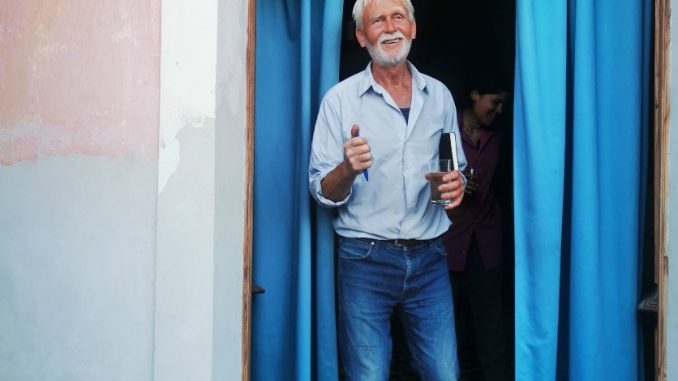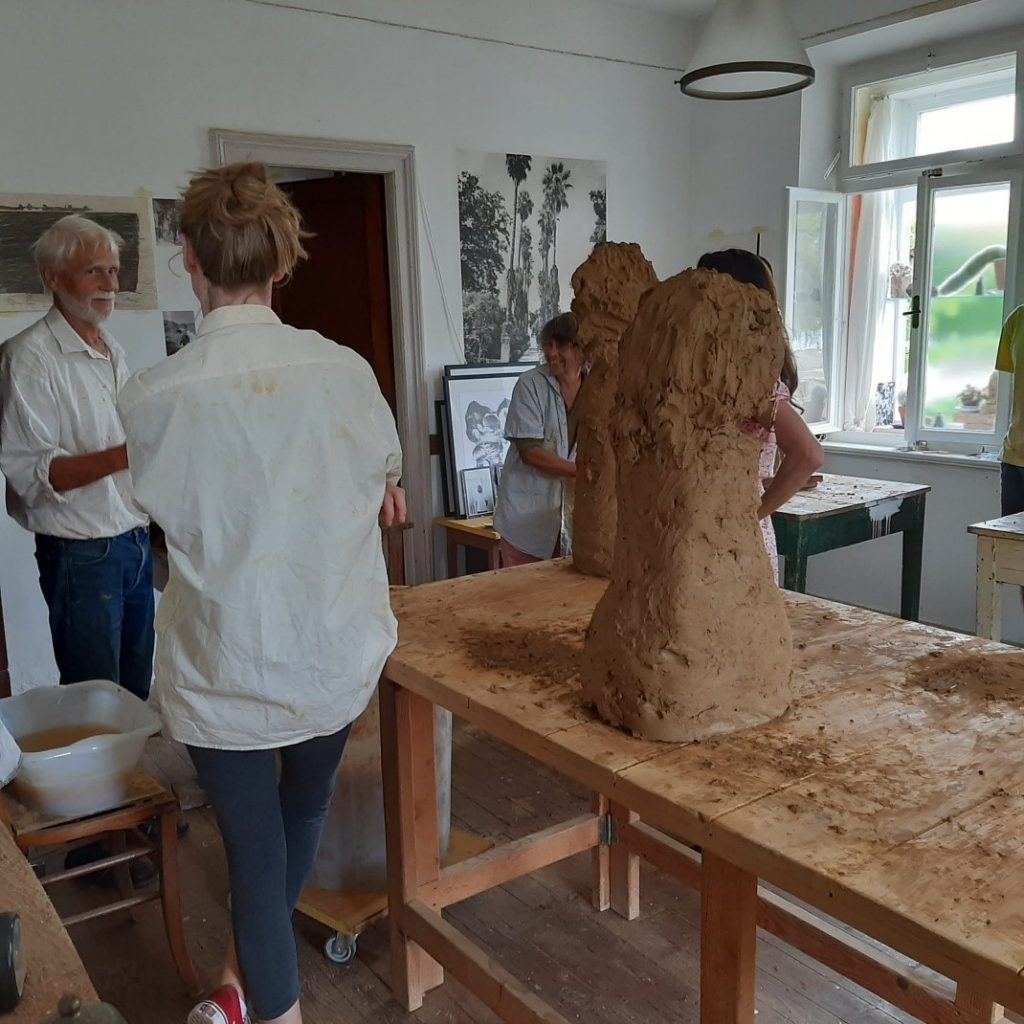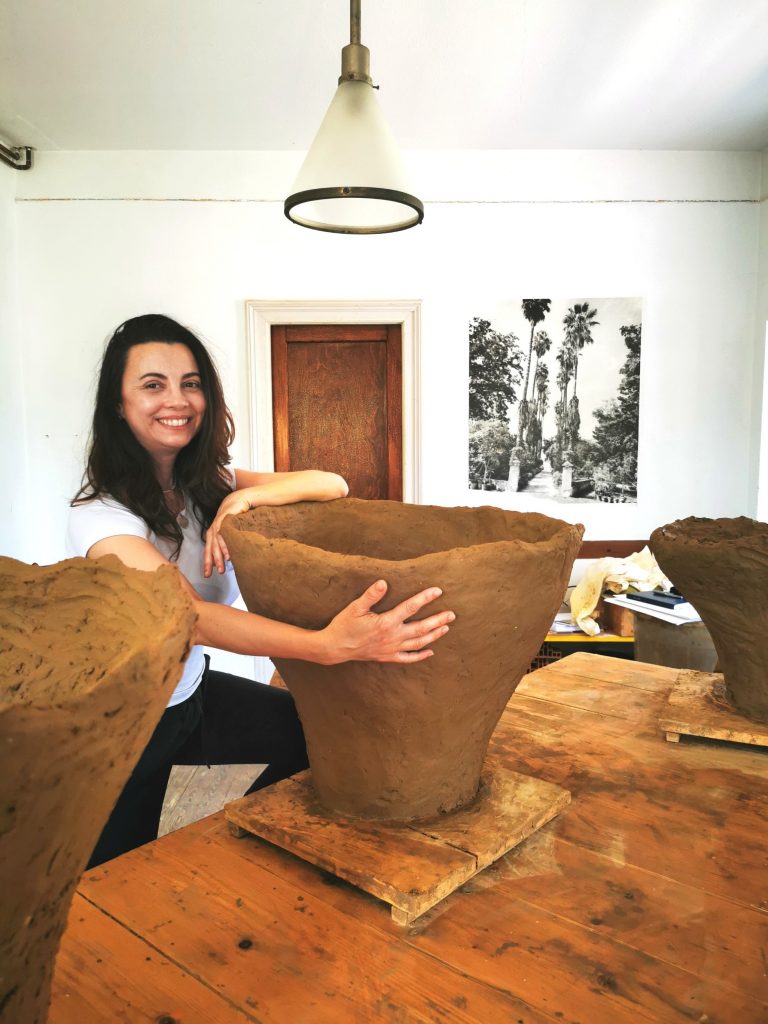
Interviewer: Vesna Matić /
We visited Balz Christian Tschopp on the island of Iž and talked about art therapy and art. He is the first Swiss art therapist and multidisciplinary expert with many years of experience in clay art therapy.
BALZ CHRISTIAN TSCHOPP, ART TERAPIST, PAINTER, WALDORF PEDAGOGUE and REHABILITATOR
Balz Christian Tschopp first came to the island of Iž 11 years ago as a pedagogue, and then as an art therapist. During 2021 and 2022 in the Oleander House he held an art therapy seminar “Human Development and Art History” in the medium of clay for art therapy specialists at the Academy of Arts and Culture in Osijek.
Dear professor, you held a seminar “Human Development and Art History” in the medium of clay for art therapy specialists at the University of Osijek. Why did you decide on such a topic and what are the peculiarities of art therapy work in the medium of clay?
As an artist and art therapist, I study the growth and development of humanity in a special way, observing what was new in human creativity in a particular artistic period and in which context. Furthermore, I instruct the participants to try to find and perceive the phase of their own growth and development with the help of works of art from various historical periods, from painting to sculpture to architecture. This is followed by a further step in which the participants, with the help of art therapy in the medium of clay, engage in a deep process of researching the point of their own growth, development, and finding space for internal shifts. The easiest way to explain working in the medium of clay is when you observe a small child or animal playing freely, with joy and full of life. While working with clay, such a joyful and vital inner impulse encourages us to physical and inner movement and very quickly, we become children ourselves.
How did art therapy start?
For the first time in the 16th century, we encounter the application of art for therapeutic purposes, in the hospital of St. Antony in Issenheim, working with seriously and terminally ill patients, those suffering from plague and ergotism. An attempt is made to make the situation easier for the patients by encouraging them to observe the scenes of the moving polyptych in order to identify and connect with one of the said scenes, with someone who suffers as much as them, understands and sympathizes with their pain. In addition, in some parts of the polyptych, there is a special attempt to give hope to patients and to emphasize what is most important in a human being – the immortal soul is important, not the transience and suffering of the body. The folding polyptych was painted by artist Matthias Grünewald and is a unique example of the use of art for therapeutic purposes in the world.
Furthermore, at the beginning of the 20th century, Freud talks about the “I” or Ego and discovers that, in addition to the visible personality of man, there is also a very strong and important inner invisible world or subconscious. Studying female hysteria, he discovers that in persons who have experienced some kind of trauma, which is hidden and suppressed in that inner world, sooner or later there is an “explosion” and manifestation of the trauma in the external and visible world.
At the same time, artists reflect and ask themselves what the essence of art is, whether art is the painting of the seen or symbolic, for example, the Passion of Jesus, or is art something completely different. Especially during his travels through Europe and Africa, Kandinsky asked himself “What happens to me when I paint?”, that is, what is the relationship between the artist and creation. He realizes that the need to paint comes from the artist’s “inside”, moving towards the top in a pyramidal way, so painting arises as part of a spiritual process.
After World War II, Dubuffet was in search of what was authentic and humane in painting, so in collaboration with artists, psychiatrists and patients, he came to the realization that when someone paints, they always paint themselves in some way. As the originator of art brut, he amassed an impressive collection of works that depict the inner world of fantasy, unusual ideas and mental states outside the framework of conventional art. We can say that the inner world mentioned by artists and psychiatrists is stronger than the body and what we see when we observe a person, and therefore it is more humane and contains what really makes us human.
Observing children, we can understand how they create from an inner need, they start with dots, lines, spots and then more and more a form is created. We can notice that their works are very specific and different. When we paint as children, conveying what we carry inside and in our heads, then we can say that we are working creatively, and in German, it would be “Gestaltung”. The way we paint or do other art is actually a reflection of our personality. However, as children grow, and especially after the age of 16, more attention is paid to thinking and analytics, so the power to express the inner being weakens. Art therapy can help with expression because it allows people to discover their inner being through art, where there is nothing that is good or bad, right or wrong. The experience is important, and the product in the form of a painting, sculpture and the like is less important.

How does an art therapy class unfold and what is your role as an art therapist?
As an art therapist, I prepare everything necessary for the clay art therapy session, organize the space, provide the material and try to enable the client’s involvement in the research process. The client begins art therapy by exploring the materials, and themselves in silence, engaging in the research process to help themsleves. In doing so, I guide the client, but I do not impose myself as an authority or put pressure on the client, but observe and feel how the client does it, I am there for them and support them.
In the beginning, it takes time for the client to stop thinking and surrender to the work, and this is helped by colours, shapes, and everything the client is exposed to during the session because they affect the client’s body, organization, and thinking. That is why it is important for the client to involve their whole body in the work, to feel the process in all their organs, and not to think and verbalize about the process. Process means life, and blockages can be a disease, so, for example, depression means being out of the process. It is important to note that we need ourselves to be present and by working in clay we come more and more in contact with ourselves, so we can feel our inner warmth. People are different on the outside, and I believe that they are even more different on the inside and that maybe sometimes it is not pleasant what we see in the forms we create in clay, maybe they are not in accordance with our expectations or during work, we increasingly notice and accept what is our so-called handwriting in clay.
After all of the above, the art therapist and the client can discuss how the work process went and what came out of it.
Why did you choose Croatia and the island of Iž as the place of your work?
The Association “Maslinova gora” (Mount of Olives) from Iž invited me 11 years ago to organize a spring seminar in Iž, and this successful cooperation continued for a number of years. I was particularly interested in organizing art therapy on such a beautiful island, and I realized that I could help both clients and the community with art therapy, and that gave me great pleasure. I held seminars on art therapy, art and pedagogy in Zagreb, Osijek, throughout Bosnia and Herzegovina and in Serbia, and the participants were mostly teachers in schools for children with special needs. I made connections between art therapy and the history of art and in a very plastic way, I show how mankind developed and grew.
With Croatia and the association Mount of Olives, I am also connected through my love for olives and cooking, but also much more than that. I connected with the local community on Iž, so every year I organize concerts in the cultural centre, and we painted the walls of the school and carried out several other initiatives.
The theory of social sculpture, developed in the 70s by Joseph Beuys, talks about social plasticity according to which everything is connected and every aspect of life should be approached creatively, and the result is that everyone can, in some way, become an artist. At the island of Iž, I got the opportunity to combine art therapy and pedagogy, art therapy and art, art therapy and working with olives, art therapy and cooking. I believe that every aspect of life should be approached creatively and life should be understood as art, everything is art.
As an art therapist, you had the opportunity to work with various populations in various countries. In what way is working with the Croatian population different from working with the population in another country?
Although each person is special and it is very difficult to generalize, it can be said that there are some similarities in art therapy work with people in Croatia. People are open and very quickly feel what is expected of them, so they easily engage in the process, which is the most important thing for art therapy. In a way, they quickly connect with the kinaesthetic-sensory level, they can feel the body from the inside, much faster than, say, northern European populations.
How do you see the future of art therapy and art?
As I mentioned before, in the modern age at one point the focus of art became the inner world, as opposed to the imitation of the outer world. It was important to open up and show what a person’s inner world is, what is inside, how different and yet similar we are. Now we have gone a step further, so the emphasis is no longer on getting into the process, connecting with oneself and showing what is inside, but a new dimension has emerged, which is noticing and connecting with others, both with people and their activities, and with by nature. Therefore, in art therapy, you are not alone, as sometimes an artist is alone in their creation, you have an art therapist who is with you, who witnesses and supports you with their presence. Therefore, I see the future of art therapy and art in connecting different people, as well as connecting different aspects and dimensions of life. As far as the future of art is concerned, everything is art and anyone can be an artist in any segment of their life.

